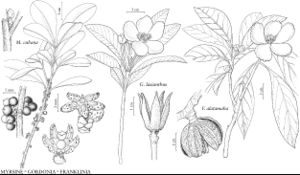Myrsine cubana
Ann. Sci. Nat., Bot., sér. 2, 16: 86. 1841,.
Shrubs or trees, to 15 m; branchlets glabrous. Leaves: petiole 4–7 mm, glabrous; blade 3.9–13.2 × 2.4–5.6 cm, surfaces punctate. Inflorescences: staminate 5–9-flowered, pistillate 3–7-flowered; peduncle 1.3–4.3 × 1.2–2.2 mm. Pedicels: 0.4–1.1 mm in staminate inflorescences, 1–1.4 mm in pistillate inflorescences, glabrous. Staminate flowers: sepals 0.7–1 mm, margins entire, densely glandular-ciliate, apex acute, surface punctate, glabrous; petals lanceolate, 2.3–2.5 mm, margins entire, densely glandular-granulose, apex acute, surface punctate, glabrous; filaments rudimentary; anthers attached at apex of corolla-tube, oblong, apex obtuse, epunctate dorsally; pistillode glabrous. Pistillate flowers similar to staminate except sepals 1–1.4 mm; petals 2.5–2.7 mm; staminodes 2.5–2.8 mm; filaments rudimentary; antherodes lanceolate, apex acuminate, apiculate; pistil punctate, glabrous; ovules 3–9. Drupes green to black, 3.5–4.5 mm diam., punctate.
Phenology: Flowering Oct–Apr; fruiting year-round.
Habitat: Mangrove formations
Elevation: 0-10 m
Distribution

Fla., West Indies (Bahamas), West Indies (Cayman Islands), West Indies (Cuba), Central America
Discussion
J. M. Ricketson and J. J. Pipoly (1997) discussed the correct application of the name Myrsine cubana. The widely used name M. floridana A. de Candolle is superfluous.
Myrsine cubana has sometimes been confused with M. guyanensis (Aublet) Kuntze, a South American species found in Brazil, the Guianas, and eastern Venezuela; see J. J. Pipoly (1992, 1992b) for the diagnostic features separating these taxa. In addition, M. cubana has a confused nomenclatural history; see J. M. Ricketson and Pipoly (1997) for a discussion.
Selected References
None.
